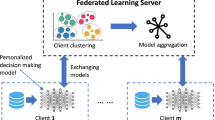Abstract
In recent years, the prevalent of location-based social networks contributes massive data for location recommendation. Although collaborative filtering (CF) algorithm has been widely employed for location recommendation, it suffers the data sparsity and the high time complexity as it estimates the similarity of users by the common locations. In this paper, we extend the two-dimensional cloud model to the multidimensional cloud model and utilize it to the measure the similarity of user preferences and user behaviors. This method not only considers the multiple attributes of users (e.g., the diversity of user preferences), but also alleviates the sparsity of location recommendation based on CF algorithm to some extent. Then we integrate the similarity of user preferences, social ties and user behaviors into CF algorithm, which is expected to mine user preferences of new locations (MUPNL) more precisely. Furthermore, in order to improve the efficiency of the MUPNL algorithm, we parallelize it with Mapreduce framework. Experimental results on Yelp academic dataset demonstrate the good performance of the distributed MUPNL algorithm in accuracy and efficiency.






Similar content being viewed by others
References
Bao, J., Zheng, Y., Wilkie, D., & Mokbel, M. (2015). Recommendations in location-based social networks: A survey. Geoinformatica, 19, 525.
Ye, M., Yin, P., & Lee, W. C. (2010). Location recommendation for location-based social networks. In Proceedings of the 18th SIGSPATIAL International Conference on Advances in Geographic Information Systems (GIS’10) (pp. 458–461).
Ye, M., Yin, P., Lee, W. C., & Lee, D. L. (2011). Exploiting geographical influence for collaborative point-of-interest recommendation. In Proceedings of the 34th International ACM SIGIR Conference on Research and Development in Information Retrieval (pp. 325–334).
Ye, M., Liu, X., & Lee, W. C. (2012). Exploring social influence for recommendation—A probabilistic generative model approach. In In Annual International ACM SIGIR Conference on Research and Development in Information Retrieval (pp. 325–334).
Ying, J. J. C., Lu, E. H. C., Kuo, W. N., & Tseng, V. S. (2012). Urban point-of-interest recommendation by mining user check-in behaviors. In Proceedings of the ACM SIGKDD International Workshop on Urban Computing (ACM, 2012) (pp. 63–70).
Bao, J., Zheng, Y., & Mokbel, M. F. (2012) Location-based and preference-aware recommendation using sparse geo-social networking data. In Gis (pp. 199–208).
Chen, C., Haiqin, Y., Irwin, K., & Michael, R. L. (2012). Fused matrix factorization with geographical and social influence in location-based social networks. In Proceedings of the 26th AAAI Conference on Artificial Intelligence.
Gao, H., Tang, J., & Liu, H. (2012) gSCorr: Modeling geo-social correlations for new check-ins on location-based social networks. In Proceedings of the 21st ACM International Conference on Information and Knowledge Management (pp. 1582–1586).
Levandoski, J. J., Sarwat, M., Eldawy, A., & Mokbel, M. F. (2012). Lars: A location-aware recommender system. In 2012 IEEE 28th International Conference on Data Engineering (ICDE) (pp. 450–461).
Zhang, J. D., & Chow, C. Y. (2013) iGSLR: Personalized geo-social location recommendation: A kernel density estimation approach. In Proceedings of the 21st ACM SIGSPATIAL International Conference on Advances in Geographic Information Systems (pp. 334–343).
Dequan, Z., & Xin, W. (2014). Probabilistic category-based location recommendation utilizing temporal influence and geographical influence. In International Conference on Data Science and Advanced Analytics, DSAA 2014, Shanghai, China, October 30–November 1, 2014 (pp. 115–121).
Xuefeng, C., Yifeng, Z., Gao, C., Shengchao, Q., Yanping, X., & Yuanshun, D. (2015). On information coverage for location category based point-of-interest recommendation. In Twenty-Ninth AAAI Conference on Artificial Intelligence.
Li, D., & Du, Y. (2007). Artificial intelligence with uncertainty. Boca Raton: CRC Press.
Li, D., Liu, C., & Gan, W. (2009). A new cognitive model: Cloud model. International Journal of Intelligent Systems, 24(3), 357.
Tobler, W. R. (1970). A computer movie simulating urban growth in the Detroit region. Geospatial Semantics First International Conference Geos, 46, 234.
Leung, W. T., Lee, D. L., & Lee, W. C. (2011). CLR: A collaborative location recommendation framework based on co-clustering. In Proceedings of the 34th International ACM SIGIR Conference on Research and Development in Information Retrieval (pp. 305–314).
Li, Q., Zheng, Y., Xie, X., Chen, Y., Liu, W., & Ma, W. Y. (2008). Mining user similarity based on location history. In Proceedings of the 16th ACM SIGSPATIAL International Conference on Advances in Geographic Information Systems (pp. 1–10).
Zheng, V. W., Cao, B., Zheng, Y., Xie, X., & Yang, Q. (2010). Collaborative filtering meets mobile recommendation: A user-centered approach. Twenty-Fourth AAAI Conference on Artificial Intelligence.
Zheng, V. W., Zheng, Y., Xie, X., & Yang, Q. (2010). Collaborative location and activity recommendations with GPS history data. In Proceedings of International World Wide Web Conference 2010.
Zheng, V. W., Zheng, Y., Xie, X., & Yang, Q. (2012). Towards mobile intelligence: Learning from GPS history data for collaborative recommendation. Artificial Intelligence, 184–185(2), 17.
Zheng, Y., & Xie, X. (2011). Learning travel recommendations from user-generated GPS traces. Acm Transactions on Intelligent Systems and Technology, 2(1), 389.
Xiao, X., Zheng, Y., Luo, Q., & Xie, X. (2010). Finding similar users using category-based location history. In Proceedings of the 18th SIGSPATIAL International Conference on Advances in Geographic Information Systems (pp. 442–445).
Ding, Y., & Li, X. (2005). Time weight collaborative filtering. In Proceedings of the 14th ACM International Conference on Information and Knowledge Management (ACM) (pp. 485–492).
Jeffrey, D., & Sanjay, G. (2004). MapReduce: Simplified data processing on large clusters. Communications of the Acm, 51(1), 107.
Amdahl, G. M. (1967). Validity of the single processor approach to achieving large scale computing capabilities. In Proceedings of the April 18-20, 1967, Spring Joint Computer Conference (ACM) (pp. 483–485).
Kumar, V., & Singh, V. (1991). Scalability of parallel algorithms for the all-pairs shortest-path problem. Journal of Parallel and Distributed Computing, 13(2), 124.
Acknowledgments
This work is funded by the National Science Fund of China (Grant No. 60872051)
Author information
Authors and Affiliations
Corresponding author
Rights and permissions
About this article
Cite this article
Wang, F., Meng, X., Zhang, Y. et al. Mining user preferences of new locations on location-based social networks: a multidimensional cloud model approach. Wireless Netw 24, 113–125 (2018). https://doi.org/10.1007/s11276-016-1316-x
Published:
Issue Date:
DOI: https://doi.org/10.1007/s11276-016-1316-x




